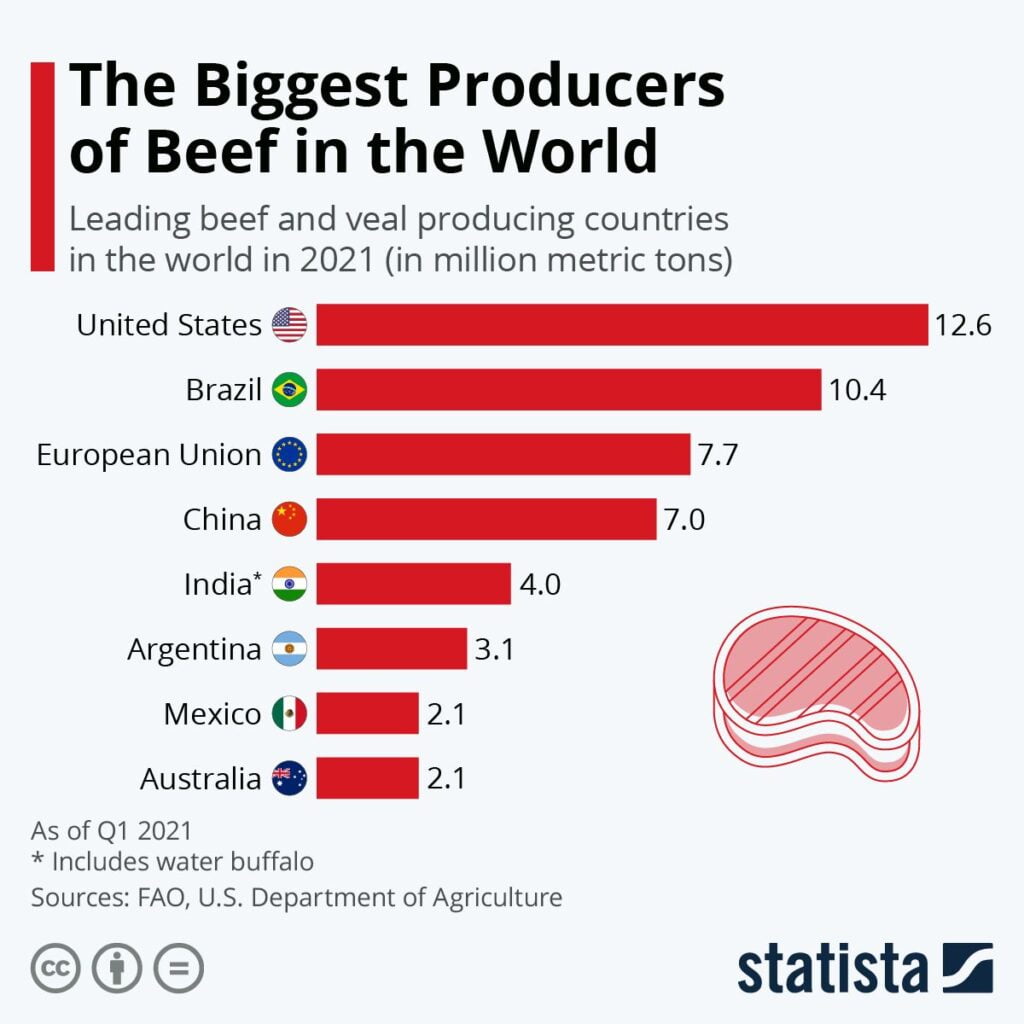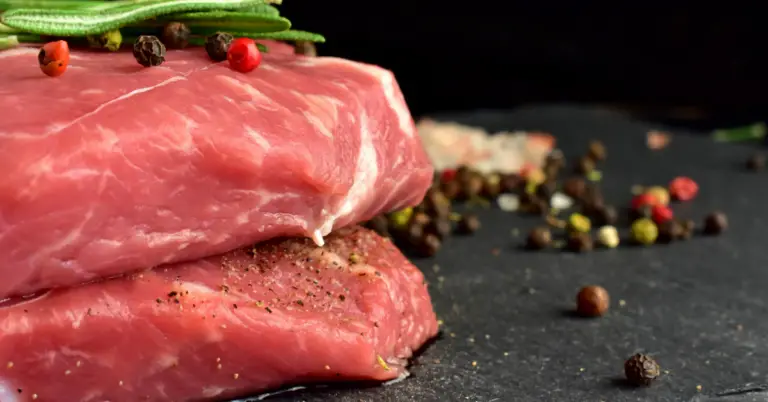According to Britannica,
Beef, flesh of mature cattle, as distinguished from veal, the flesh of calves. The best beef is obtained from early maturing, special beef breeds. High-quality beef is firm, velvety, fine-grained, lean, bright red in colour and well-marbled. The fat is smooth, creamy white, and well distributed.
In young beef the bones are soft, porous, and red; the less desirable mature beef has hard white bones. Beef tenderness and flavour are improved by aging; in one common aging method the carcass is hung for about two weeks at approximately 36 °F (2 °C), encouraging physical changes in the muscle tissue that enhance the quality of the meat.
Beef production is a cornerstone of the global agricultural industry, significantly impacting economies, food security, and cultural practices. The United States holds the title of the world’s largest beef producer, underscoring its advanced agricultural practices, extensive resources, and robust infrastructure. This article delves into the details of U.S. beef production, explores recent research, and answers common questions about this vital industry. Let’s find out the largest beef producer country in the world.
The United States: Leading the World in Beef Production
1. Production Scale
The United States leads the world in beef production, contributing significantly to both the domestic and international beef markets. Annually, the U.S. produces approximately 12.6 million metric tons of beef, which accounts for nearly 20% of the global beef supply. A combination of extensive grazing lands, sophisticated feedlot systems, and state-of-the-art processing facilities supports this massive output.
2. Advanced Farming Techniques
The U.S. beef industry benefits from advanced farming techniques that enhance productivity and quality. Innovations in cattle breeding, such as selective breeding and genetic improvements, have led to herds that grow faster and produce more meat. Additionally, optimized feeding practices, including the use of nutrient-rich feed and efficient feeding schedules, ensure that cattle reach market weight in a timely manner.
3. Extensive Grazing Land and Feedlots
The U.S. has vast grazing lands that provide ample space for cattle to roam and graze. These lands are complemented by large feedlots where cattle are fed grain-based diets to fatten them up before slaughter. This combination of grazing and feedlot finishing contributes to the high quality of U.S. beef, known for its marbling and tenderness.
4. Innovative Technology
Technological advancements play a crucial role in U.S. beef production. Technology enhances every aspect of cattle farming from automated feeding systems to advanced veterinary care. Meat processing facilities also utilize cutting-edge technology to ensure efficiency, hygiene, and quality control.
5. Strong Domestic Demand
High domestic consumption drives the U.S. beef industry. Americans consume over 27 billion pounds of beef annually, making it a staple in the national diet. This strong demand supports continuous production and innovation within the industry.
Other Top Beef-Producing Countries
1. Brazil
Brazil is the second-largest beef producer globally, known for its vast pastures and favorable climate for cattle ranching. The country has a strong export market, supplying beef to various regions, including the Middle East, Europe, and Asia. Brazilian beef is renowned for its quality and competitive pricing.
2. China
China ranks third in beef production, driven by rising domestic demand and significant investments in agricultural technology. While China imports a substantial amount of beef to meet its consumption needs, its domestic production continues to grow steadily.

3. India
India is notable for its large cattle population, which is primarily used for dairy and draft purposes. While beef production is limited due to cultural and religious factors, India is a leading producer of buffalo meat, which is a significant part of its meat export industry.
4. Argentina
Argentina is renowned for its beef quality, with a long-standing tradition of cattle ranching. Argentine beef is highly prized in the global market, particularly in Europe and Asia, for its flavor and tenderness, attributed to the country’s extensive grass-fed cattle farming.
Recent Research and Developments
1. Sustainable Beef Production
Sustainability is a growing focus in the U.S. beef industry. Recent research has explored ways to reduce the environmental impact of beef production. For example, studies have investigated the potential of rotational grazing to improve soil health and carbon sequestration. Additionally, there is ongoing research into reducing methane emissions from cattle through dietary adjustments and genetic selection.
2. Improving Animal Welfare
Animal welfare is a critical concern in modern beef production. Recent studies have examined the effects of different housing systems, handling practices, and transport conditions on cattle well-being. Implementing best practices in animal welfare not only improves the lives of the animals but also enhances the quality of the meat.
3. Enhancing Beef Quality
Research into beef quality focuses on improving traits such as tenderness, flavor, and nutritional content. Advances in genetic testing allow for the selection of cattle with superior meat quality traits. Additionally, post-slaughter handling techniques, such as aging and marinating, are continually refined to enhance the consumer experience.
4. Food Safety Innovations
Ensuring food safety is paramount in beef production. Recent innovations include the development of more effective pathogen detection methods and interventions to reduce contamination during processing. Research into antimicrobial resistance and the use of natural preservatives is also advancing to ensure the safety of beef products.
Global Impact and Trade
1. Export Market
The United States is also a leading exporter of beef, supplying high-quality meat to various countries worldwide. Major export markets include Japan, South Korea, Mexico, and Canada. U.S. beef is prized for its quality, safety, and consistency, making it a preferred choice in international markets.
2. Trade Agreements
Trade agreements play a crucial role in the global beef market. The United States engages in bilateral and multilateral trade agreements to facilitate beef exports. These agreements help reduce tariffs, ensure market access, and establish standards that promote fair trade.
3. Competition and Collaboration
The U.S. beef industry faces competition from other top producers like Brazil, Argentina, and Australia. However, there is also significant collaboration in areas such as research, sustainability, and food safety. Sharing best practices and technological advancements benefits the global beef industry as a whole.
Conclusion
The United States stands as the largest beef producer in the world, thanks to its advanced agricultural practices, extensive resources, and strong domestic market. Recent research and innovations in sustainability, animal welfare, and food safety continue to shape the industry, ensuring that U.S. beef remains a high-quality and globally sought-after product. Understanding the dynamics of U.S. beef production provides valuable insights into the broader context of global agriculture and food security.
FAQ’s
1. Why is the United States the largest beef producer in the world?
The United States is the largest beef producer due to its vast grazing lands, advanced farming techniques, and strong domestic demand. The country’s infrastructure supports large-scale production, and technological innovations continually enhance efficiency and quality.
2. How does U.S. beef production impact the environment?
Beef production has a significant environmental impact, including greenhouse gas emissions, water usage, and land degradation. However, the U.S. beef industry is making strides in sustainability, with research focused on reducing emissions, improving land management, and enhancing resource efficiency.
3. What measures are taken to ensure the quality of U.S. beef?
The quality of U.S. beef is ensured through strict regulations, advanced breeding techniques, and optimized feeding practices. Post-slaughter processes, such as aging and marinating, also play a role in enhancing meat quality. Regular inspections and adherence to safety standards help maintain high-quality beef products.
4. How does the U.S. beef industry address animal welfare concerns?
Animal welfare is a priority in the U.S. beef industry. Best practices in housing, handling, and transport are implemented to ensure the well-being of cattle. Ongoing research and training programs help farmers adopt humane practices that benefit both the animals and the industry.
5. What role does technology play in U.S. beef production?
Technology is integral to U.S. beef production, enhancing efficiency, quality, and safety. Innovations such as automated feeding systems, advanced genetic testing, and state-of-the-art processing facilities improve every stage of beef production. Technology also aids in monitoring animal health and implementing sustainable practices.
6. How does the U.S. beef industry contribute to the economy?
The U.S. beef industry is a major contributor to the economy, providing jobs, generating revenue, and supporting ancillary industries. Beef production involves a wide range of activities, from farming and processing to distribution and retail. The industry’s economic impact extends to rural communities, where cattle farming is often a primary source of income.
